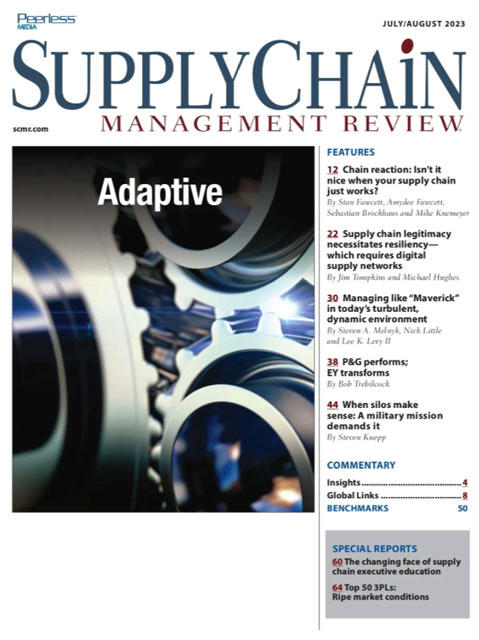Sorry, but your login has failed. Please recheck your login information and resubmit. If your subscription has expired, renew here.
July-August 2023
Most business people have heard the phrase “move fast and break things.” But how do you move fast, break things, and remain profitable? Inside this issue of Supply Chain Management Review are the answers—we hope. We have two articles this month that address decision-making. The articles (“Chain reaction: Isn’t it nice when your supply chain just works?” and “Managing like ‘Maverick’ in today’s turbulent, dynamic environment”) approach the topic of decision-making from decidedly different perspectives, but I believe they are more similar than they appear. Browse this issue archive.Need Help? Contact customer service 847-559-7581 More options
This is a supply chain story from a world where nothing is ever exactly as it appears at first glance.
Kick the tires and light the fires?
In late 2005, Iraq was both a war zone of international importance and an ancient collection of tribes and tribal ideologies—Kurds, Shiite, and Sunni, to name three. The challenge for Iraq’s leaders and its U.S. advisors was to build a stable society that allowed groups with long-held animosity toward each other to coexist peacefully. While there were a dizzying array of components and programs to making this happen, this particular story focuses on the transportation of more than 3,000 police cadets from Iraq to Jordan for an enhanced training environment.
Making that happen involved not just many moving pieces, but also cooperation between Iraq, Jordan, Israel, and the United States using two 125-seat B737s with Sudanese registration. This is a world of pre-set agreements and processes in a war zone environment where visual had special meaning. All 24 flights over four days followed visual flight rules, meaning the pilots were on their own for every takeoff and landing. So was I, the project manager, carrying into and out of Baghdad $250,000 in cash in a pay-as-you-go framework for all needed supplies and services.
As you can well imagine because you are reading this story, the 26 people on the team got the cadets loaded in Baghdad, transported and unloaded in Amman in the four-day window allowed. Overall, it was completed without much incident (the 10-cadet fist fight on the first flight at 25,000 feet was a one-off) and within budget. I even had $6,000 left in my pocket when all was said and done.
That said, there’s also no underestimating the importance of managing this supply chain in silos. That’s not always the case, but this time the silo approach was the best for this supply chain. Here’s how it went.

This complete article is available to subscribers only.
Log in now for full access or start your PLUS+ subscription for instant access.
SC
MR
Sorry, but your login has failed. Please recheck your login information and resubmit. If your subscription has expired, renew here.
July-August 2023
Most business people have heard the phrase “move fast and break things.” But how do you move fast, break things, and remain profitable? Inside this issue of Supply Chain Management Review are the answers—we… Browse this issue archive. Access your online digital edition. Download a PDF file of the July-August 2023 issue.This is a supply chain story from a world where nothing is ever exactly as it appears at first glance.
Kick the tires and light the fires?
In late 2005, Iraq was both a war zone of international importance and an ancient collection of tribes and tribal ideologies—Kurds, Shiite, and Sunni, to name three. The challenge for Iraq’s leaders and its U.S. advisors was to build a stable society that allowed groups with long-held animosity toward each other to coexist peacefully. While there were a dizzying array of components and programs to making this happen, this particular story focuses on the transportation of more than 3,000 police cadets from Iraq to Jordan for an enhanced training environment.
Making that happen involved not just many moving pieces, but also cooperation between Iraq, Jordan, Israel, and the United States using two 125-seat B737s with Sudanese registration. This is a world of pre-set agreements and processes in a war zone environment where visual had special meaning. All 24 flights over four days followed visual flight rules, meaning the pilots were on their own for every takeoff and landing. So was I, the project manager, carrying into and out of Baghdad $250,000 in cash in a pay-as-you-go framework for all needed supplies and services.
As you can well imagine because you are reading this story, the 26 people on the team got the cadets loaded in Baghdad, transported and unloaded in Amman in the four-day window allowed. Overall, it was completed without much incident (the 10-cadet fist fight on the first flight at 25,000 feet was a one-off) and within budget. I even had $6,000 left in my pocket when all was said and done.
That said, there’s also no underestimating the importance of managing this supply chain in silos. That’s not always the case, but this time the silo approach was the best for this supply chain. Here’s how it went.
SC
MR


Latest Supply Chain News
- Planning fatigue may be settling in
- Inflation, economic worries among top supply chain concerns for SMBs
- April Services PMI declines following 15 months of growth, reports ISM
- Attacking stubborn COGS inflation with Digital Design-and-Source-to-Value
- Despite American political environment, global geopolitical risks may be easing
- More News
Latest Podcast

 Explore
Explore
Software & Technology News
- Technology’s role in mending supply chain fragility after recent disruptions
- Tech investments bring revenue increases, survey finds
- Survey reveals strategies for addressing supply chain, logistics labor shortages
- AI, virtual reality is bringing experiential learning into the modern age
- Humanoid robots’ place in an intralogistics smart robot strategy
- Tips for CIOs to overcome technology talent acquisition troubles
- More Software & Technology
Latest Software & Technology Resources

Subscribe

Supply Chain Management Review delivers the best industry content.

Editors’ Picks






